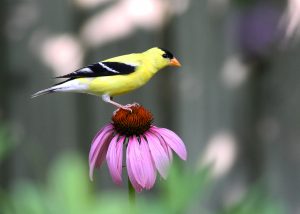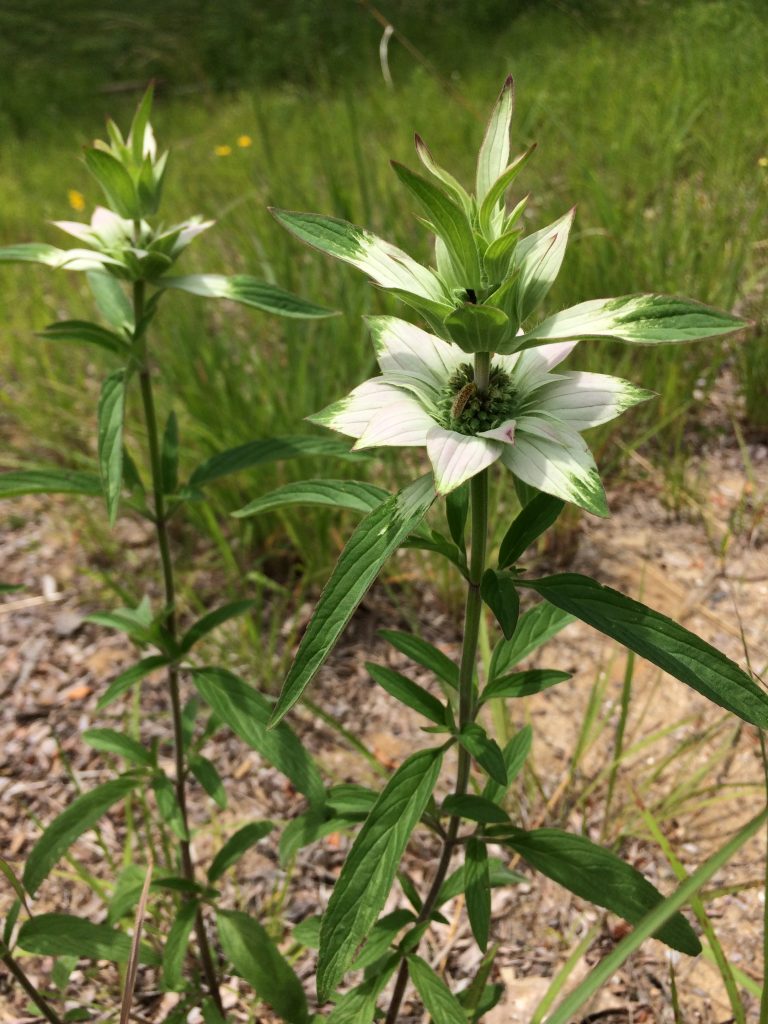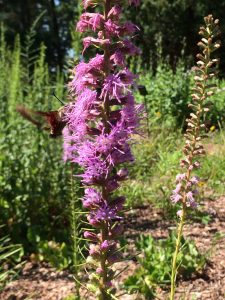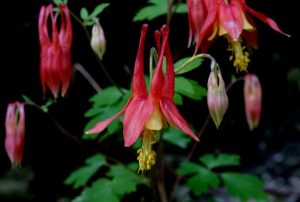Support Birds, Pollinators, and Wildlife with Native Bird Garden Kits by Michigan Audubon!
**2018 Bird Garden Kit sales have ended – thank you for your interest! Visit our Native Plants for Birds page for more gardening inspiration.**
Do you love feeding the birds in your backyard? Attract more birds to your yard by planting a bird feeder – by using native plants! On average, native plants attract 4x more insects than ornamental or non-native plants. Native plants provide seeds, nectar, berries, cover, and nesting material, and attract loads of insects for birds to feed their young. These three gardens have been carefully selected specifically to attract birds and pollinators. Each garden will thrive under slightly different site conditions, so take note of the light levels, moisture, and soil texture in your yard and choose your garden kit wisely. No matter which garden kit you select, the birds will thank you!

Purple Coneflower (Echinacea purpurea) by Will Stuart
What you will receive: Each garden kit contains 32, 2” pots of 8 species of flowers, grasses, and/or sedges. The 2” potted plants are larger and more robust than a plug size. Exact species will depend on nursery availability, but any substitutions will support birds and be well-suited to the kits’ recommended growing conditions. Each kit also comes with 4 plugs of fast-growing shrubs, which will soon attract even more birds, pollinators, and wildlife. These shrubs will add vertical height and layered visual interest to your new garden as well. Planted 12” apart in a triangle pattern, this kit will cover approximately 32 ft2.
Garden Kit Price: $110 + tax (total $116.60)
Native Bird Garden Kits will be available for pick-up only at the Michigan Audubon office (2310 Science Pkwy, Okemos, MI 48864) on:
Friday, June 8, 3 – 6 PM and Saturday, June 9, 10 AM – 12 PM
Why buy the Bird Garden Kit? Not every native plant is a “powerhouse” for birds, but these kits were carefully curated with birds, pollinators, and wildlife in mind. Each kit is assembled with plant species that are hardy and that grow well together – making it more likely that these plants will survive and thrive together over the long-term. These kits are suited specifically for three common site conditions, making it easier to get the right plant for the right place. Ultimately, planting a new native garden can be daunting – there are so many plants to choose from and many factors to consider. We hope these kits offer an easy introduction to gardening with native plants and give everyone the confidence to explore and design with native plants in the future.

Unique foliage and flowers of Horsemint
(Monarda punctata)
Garden 1: Full sun & dry soils
If the sun beats down and the soils are parched in your yard, this garden may be for you! These are hardy, sun-loving species that are adapted to poor soils. This garden could be a great option for a failing, withered patch of lawn, the south-facing side of a building, or perhaps a curbside urban garden (check with any local ordinances before planting a curbside garden). These plants are overall relatively short (<2’ tall), but may be accented by a few tall, spindly flower stalks (blazing stars or sunflowers).
Possible plant species for this kit include: Whorled Milkweed, Sand Coreopsis, Western Sunflower, Rough Blazing Star, Penstemon, Prairie Dropseed, or Horsemint
Shrub: Northern bush honeysuckle, Diervilla lonicera (mature height 1–3’)
Birds & pollinators attracted to this garden may include: Ruby-throated hummingbird, American goldfinch, Black-capped chickadee, and Monarch butterfly

Hummingbird clearwing on marsh blazingstar
(Liatris spicata)
Garden 2: Rain garden
Rain gardens help to collect and filter water and are especially helpful in collecting runoff from gutters, driveways, sidewalks, or roads. This garden is not designed to retain water for long periods of time like a pond, but instead these plants will collect water temporarily and slowly percolate it back into the water table. Plant this garden in a natural depression in your yard where water collects in spring, or dig a shallow depression <10’ away from your foundation where downspouts empty.
Possible plant species for this kit include: Canada Anemone, Swamp Milkweed, Beardtongue, Black-Eyed Susan, Culver’s-Root, Southern Blue Flag, Blue Lobelia, and Marsh Blazing Star.
Shrub: Red-osier dogwood (mature height: 3-9’)
Birds & pollinators attracted to this garden may include: Song sparrow, Common yellowthroat, Gray catbird, and Hummingbird clearwing.

Wild columbine (Aquilegia canadensis) attracts hummingbirds
Photo by Will Stuart
Garden 3: Shade & average soils
Create a wooded wonderland with this shade garden kit! These species will do best in light or dappled shade, but will tolerate full shade as well. Shade-adapted plants often feature interesting leaf shapes and textures that are sure to delight even after the blooms have faded. Many woodland birds forage in the lush leaf litter or find refuge under thick ground cover or brush.
Possible plant species for this kit include: Heart-Leaved Aster, Columbine, Wild Ginger, Wood Poppy, Plantain Sedge, Bottlebrush Grass, Canada Anemone, and Golden Alexander.
Shrub: Silky dogwood (mature height: 3-9’)
Birds & pollinators attracted to this garden may include: Ruby-throated hummingbird, Hermit thrush, White-throated sparrow, and Black swallowtail.
[vc_separator type=”” size=”small” icon=””]Tips to plant and maintain your bird garden:
- Site preparation – Make sure your garden space is weed free before planting. If you are converting lawn to a garden space, visit the Native Connections website and planting guide for advice (http://nativeconnections.net/blog/?page_id=89).
- Soil amendments – Many of the plant species selected for these kits are hardy, tough plants that tolerate a range of conditions. In general, avoid using soil amendments and instead focus on selecting the right plants for your site. Using top soil is not recommended as it often brings in new weeds, which means more work for you later.
- Mulch – a 3-inch layer of twice ground red pine bark mulch (no dyes) helps to retain moisture and suppress weeds during establishment of your garden. Each kit will contain at least one grass, sedge, or ground cover flowering plant that is meant to eventually fill in gaps and serve as a living, green mulch.
- Plant 12” on center – The kits are composed of species that naturally grow together in Michigan. Planting closely can help retain moisture and regulate the ground temperature, creating a more stable local environment for the plants. As the plants mature, they will form a close-knit habitat patch that provides a continuous layer of cover and resources for birds, insects, and wildlife while leaving less room for weeds.
- First year watering – Watering is recommended, especially right after planting and throughout the first growing season. After the first year, watering is necessary only during periods of drought.
- Preventing browse – While some of these species are distasteful to herbivores (for example, plants with hairy leaves, strong scents, or milky sap) there are no plants that are completely safe from a hungry deer, rabbit, or groundhog. Especially in the first year, apply a copious amount of deterrent spray to herbaceous plants and use a wire cage or plastic tree tube around woody plants. Older, established plants can handle more browse, but continue to use these deterrents as needed.
- Avoid fall clean-up – Fall and winter can be tough times for birds, insects, and other wildlife. By delaying your garden cleanup until spring, you will be providing food and cover during harsh conditions. Winter seed heads attract sparrows, finches, titmice, chickadees, and more so be sure to leave them standing. Many insects overwinter in dried plant stems and leaf litter – try to leave piles of these in your yard instead of sending them curbside (the birds will thank you!).
Order your native bird garden kit today!
Please place your order below to pay by credit card or Paypal. To pay by check, please include this order form indicating the garden kit you would like to order. Make checks out to “Michigan Audubon”.
The last day to order is Tuesday, May 29.
